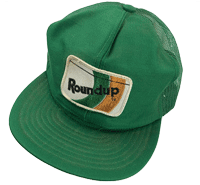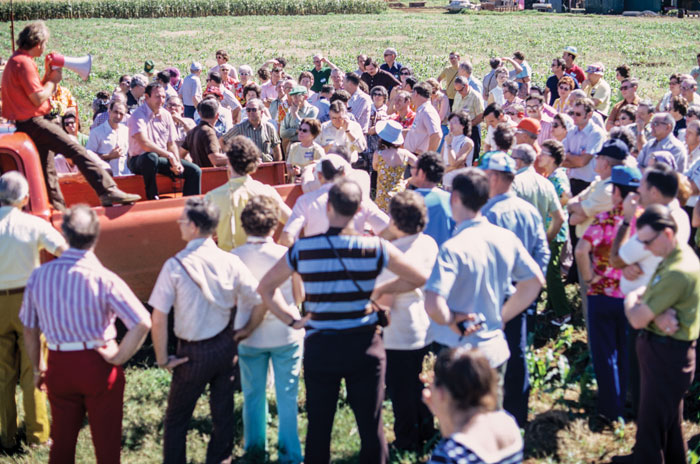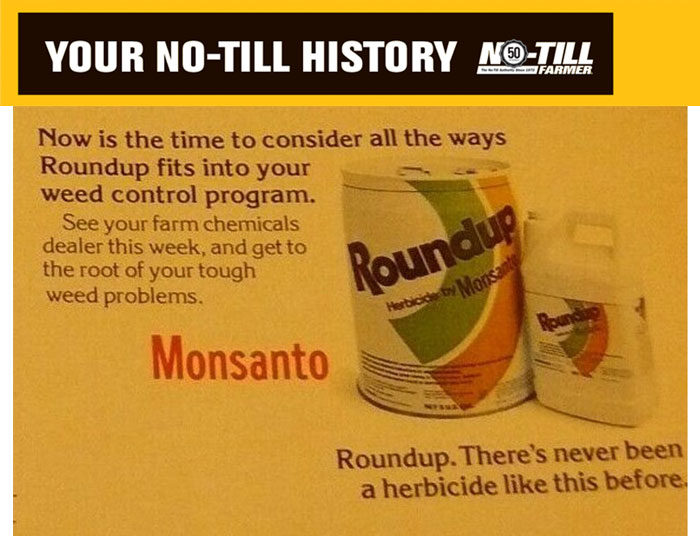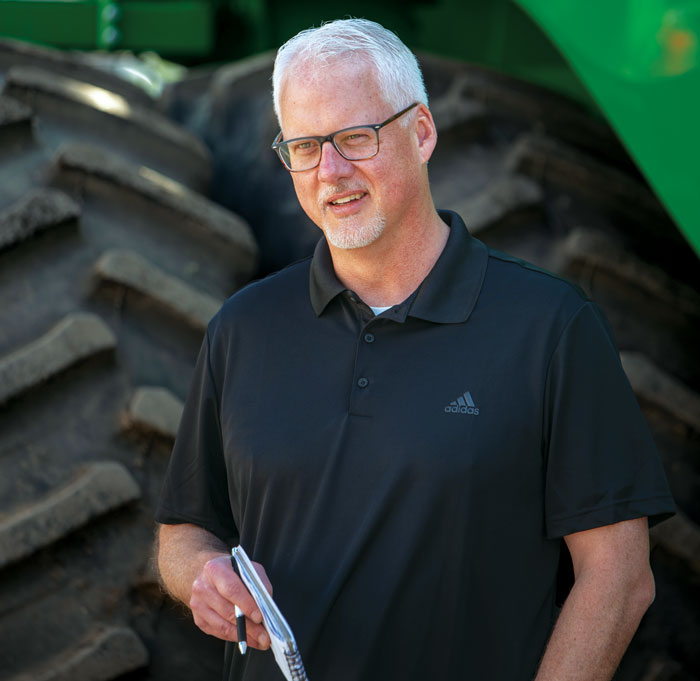Editor’s Note: In “No-Till’s Herbicide History, Part I”, we examined the early herbicides -- 2, 4-D, atrazine and paraquat -- that helped farmers looking to give the fledgling no-till practice a try. Part II focused on the remarkable fortunes for no-tillage that occurred when glyphosate was released as Roundup in 1976.
Glyphosate (or Roundup) brought to market by Monsanto in the mid 1970s and now owned by Bayer) is a virtually ideal herbicide, says international weed authority Dr. Stephen Powles and a “once in 100-years breakthrough.”
The Australian, who has presented at the National No-Tillage Conference, adds that glyphosate “is as important for reliable global food production as penicillin is for battling disease.”
Farmers on the 1974 and 1975 Hawaii trips run by No-Till Farmer saw the new herbicide in research plots. Approved to much anticipation in 1976, farmers suddenly had access to a product that promised to eradicate hundreds of annual and perennial weeds. Soon, troublesome weeds would no longer be a defensible excuse for plowing.
Roundup Was Different...

In 1970, most farmers believed they had no choice but to use herbicides and tilling to control weeds. At the time, most herbicides were pre-emergent, meaning they created a chemical barrier on the surface of a field and killed weeds when they sprouted through this barrier and came into contact5 with the herbicide. To be effective, pre-emergent herbicides had to spread when they were applied to fields, ensuring a consistent, even barrier against sprouting weeds. They also needed to stay active for a long time so they could continue to be effective after the spring rainy season.
These two traits were environmentally problematic because pre-emergent herbicides could wash into streams and ground water, potentially affecting wildlife and fish.
The original Roundup herbicide was different. It was found to decompose into natural products -- carbon dioxide, phosphoric acid and ammonia -- and also found to be safe for humans and wildlife. Environmentally speaking, the original herbicide proved to be one of, if not the safest, herbicides in the history of agriculture.
SOURCE: Bayer (which acquired Monsanto in 2018) materials on Roundup’s History
It’s no coincidence that U.S. no-till acres grew 2.5 times in Roundup’s first 10 years (and 7-fold by the time the exclusive patent expired in 2000). Its enormous impact on no-till — on yields, income and ability to farm more acres with less fuel, machinery and labor — is difficult to quantify, as is the value of keeping soil in its place and avoiding the runoff of sediment and fertilizer.
Despite the ongoing controversy over the potential harm to humans, no one can argue what it’s done for a global agriculture faced with ever more mouths to feed, and how it boosted no-till’s prospects for conservation.
To tell the history of glyphosate, we turn to a discovery of our own. We located a 59-page transcript (an oral history project sponsored by the Society of Chemical Industry) of Wilkes University Chemistry Professor Dr. James J. Bohning’s 1994 interview with glyphosate herbicide patentee John E. Franz of Monsanto. Franz is now 92.

John E. Franz earned $5 from Monsanto for discovering glyphosate’s herbicidal properties in 1970. At age 92, he still resides in the St. Louis area.
An Amazing Three-Peated Discovery
According to Roundup history by Bayer, Dr. Phil Hamm was the head of Monsanto’s herbicide screening program and was excited about two compounds that were submitted from chemists in another Monsanto division that were studied as water softeners. He asked Franz (who had transferred into the new Ag Division in 1967) to study them for herbicidal use.
Franz theorized that a beneficial compound might be produced during the plant’s metabolic process, and if he was lucky, he might be able to synthesize one of these compounds. In 1970, the third compound he synthesized (glyphosate) would become the active ingredient in the original Roundup formulation that would change the face of farming.
Franz recalled how he thought he’d made a new compound. “Monsanto’s legal team did a more thorough search and found a patent issued to Stauffer in 1961 for glyphosate relative to phosphonic acids. Stauffer only saw its prospects as a descaling and metal chelating agent.
Indiana no-tiller and conservationist Ray McCormick staunchly defends glyphosate.
“It’s going to save the planet because no-till, cover crops and soil health help sequester the carbon, and Roundup made that possible. Roundup and Monsanto have been heroes…”
“Even though Stauffer was an agriculture company, they didn’t realize that it had any herbicidal properties,” he said. “They never tested it.”
So while Stauffer (1960) had glyphosate 10 years before Franz and Monsanto (1970), Franz also pointed to a third player who failed to understand glyphosate’s capabilities. In 1950, glyphosate “was made at an obscure pharmaceutical company called Cilag in Switzerland,” he says. “Chemist Dr. Henri Martin made it as a possible antibiotic. When they tested it and it didn’t work, they just put it in their chemical storeroom.” Martin’s work was never published.

The No-Till Farmer meetings in Hawaii not only introduced a lot of farmers to the new no-till concept, but also gave them a look at glyphosate in 1974, 2 years before it would be approved for use.
When Cilag went out of business, Franz said Alfred Bader of Sigma-Aldrich purchased its research samples, including glyphosate, and offered them for sale in the firm’s catalog of rare chemicals. “Anybody could have bought this compound before I even made it.” Had any samples been screened for herbicidal use, no-till could have seen a better start than its plodding pace of just 3.3 million acres in its first 10 years of commercial use.
After a series of great years to start the 1970s, Stauffer fell on hard times and was sold to ICI in 1987. Meanwhile, by the late 1980s, Monsanto was earning roughly $1 billion per year from Roundup alone, Franz said.
How it Works
Franz admitted that what made glyphosate’s herbicidal powers active as a herbicide was not well understood initially. Many years later, German professor Dr. Nick Amrhein “found that glyphosate inhibits a specific enzyme in plants that isn’t present in other living organisms, with the exception of some fungi and bacteria. Glyphosate is the only commercial herbicide known to inhibit the enzyme called EPSP synthase (present in most plants). It’s very specific, and no one really, today, still knows why,” he says.
“With most herbicide classes that we have today, you can make hundreds of analogs with similar activity … but not glyphosate. Unbelievable.”
Glyphosate’s Future
With herbicide resistance compounding glyphosate’s regulatory uncertainty, Powles tries to manage farmers’ expectations for glyphosate’s replacement. Beyond the frequency of another “rare and precious” discovery, he says it’s far more difficult to bring products to the market today among regulatory conditions. In recent years, new herbicide development is said to take a decade or longer and require $300 million in investment.
Franz on Glyphosate’s First Field Test
In their 1994 interview, Dr. James J. Bohning asked glyphosate’s discoverer, John Franz, how long it took after the synthesis of his discovery for a field test to show that its promise.
“About 3 months,” Franz laughed. As a matter of fact, when Dr. Phil Hamm (head of Monsanto’s herbicide screening program) saw it in the greenhouse the first time, he said, ‘It’s commercial.’ Just like that.
“Everybody else said, ‘Oh, come on; you can’t know that.’ He knew it. Of course, he had a lot of experience, and he predicted it right off the bat. Well, they really couldn’t tell that from the greenhouse experiments. They did a lot in the greenhouse, what were called primary screening experiments. They also had a whole set of what they called secondary screens, and they skipped those.
“They just took it out in the field because it was getting late in the season. If they wanted to get field studies done, they had to get them out fast before winter set in. So, they went right out in the field, and it was successful, very successful. So they knew by the end of the year that it was likely to be commercial, that fast. Yes, it was amazing,
“The plant physiologist who took it out in the field was actually on a plane coming to the test site when he saw the results on the ground. He wrote a big ‘Eureka!’ over the top of the report. This was exciting because it was a major objective in ag to discover a potent new perennial herbicide; it was one of the major projects that they had wanted to do, by whatever means.”
For additional reading, see:
John E. Franz & the Glyphosate Discovery
The 2024 No-Till History Series is supported by Calmer Corn Heads. For more historical content, including video and multimedia, visit No-TillFarmer.com/HistorySeries.








Post a comment
Report Abusive Comment